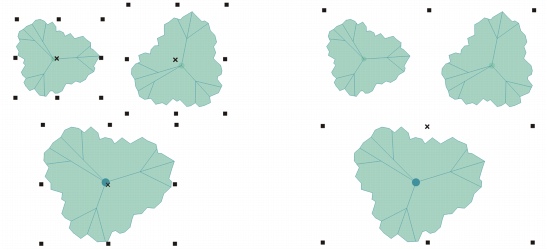Grouping objects
When you group two or more objects, they are treated as a single unit but retain their individual attributes. Grouping lets you apply the same formatting, properties, and other changes to all the objects within the group at the same time. In addition, grouping helps prevent accidental changes to the position of an object in relation to other objects. You can also create nested groups by grouping together existing groups.

Single objects retain their attributes when they are grouped.
You can add objects to or remove objects from a group, and you can delete objects that are members of a group. You can also edit a single object in a group without ungrouping the objects. If you want to edit multiple objects in a group at the same time, you must first ungroup the objects. If a group contains nested groups, you can ungroup all objects in the nested groups simultaneously.
To group objects |
![]()
|
•
|
|
You can select objects from different layers and group them; however, after objects are grouped, they reside on the same layer and are stacked on top of one another.
|
![]()
|
•
|
|
You can create a nested group by selecting two or more groups of objects and clicking Arrange
|
|
•
|
|
You can also group objects by clicking Window
|
To add an object to a group |
To remove an object from a group |
![]()
|
•
|
|
You can also remove an object from a group by clicking the object in the object list and dragging it out of the group.
|
To edit a single object in a group |
![]()
|
•
|
|
You can also select a single object in a group by clicking the name of an object in the Object manager docker. To access the Object manager docker, click Tools
|
To ungroup objects |
|
•
|
Ungroup all — breaks one or more groups into individual objects, including objects within nested groups
|
![]()
|
•
|
|
You can also ungroup all nested groups within a group by clicking the Ungroup all button
|